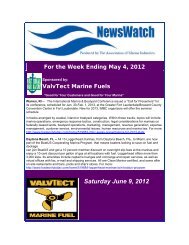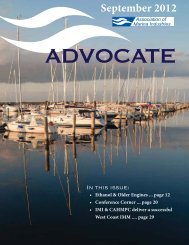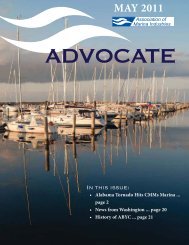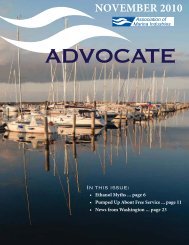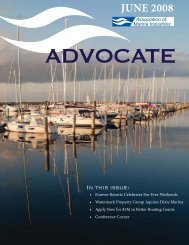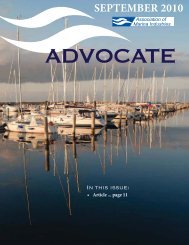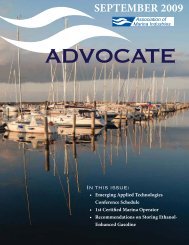C6.8.2 Circular pontoons load in a non-linear fashion. As each increment <strong>of</strong>applied load sinks a circular pontoon deeper into the water, the lower half <strong>of</strong> thediameter responds with a disproportionally greater buoyant uplift, <strong>and</strong> the upperhalf responds with disproportionally lesser buoyant uplift.C7. DeckingDecking is the element in a marina berthing system that is probably most importantto boaters. They don’t much care what kind <strong>of</strong> pontoons are used or how big utilityconduits are. But the decking is something they walk on, sit on, roll their carts over,sweep, hose <strong>of</strong>f, <strong>and</strong> either love or hate depending on how it functions.C7.1 Decking can be attached to a structural frame, or it can be part <strong>of</strong> thestructural frame as in the case <strong>of</strong> cast concrete floats. Decking used in marinasincludes various types <strong>of</strong> wood, pressure treated or untreated; recycled plasticlumber products; metal extrusions; fiberglass; <strong>and</strong> concrete.CC7.2 Marina decking should be oriented so the “grain” runs across the primarydirection <strong>of</strong> travel. Decking grain includes broom <strong>and</strong> brush finishes on concretedocks; gaps between lumber decking; <strong>and</strong> ridges, serrations, knurling marks <strong>and</strong>other traction enhancing elements imparted to extruded metal <strong>and</strong> plastic decking.C7.2.1 The decking on an accessible route shall not have gaps wider than½ inch, <strong>and</strong> the gaps must be perpendicular to the path <strong>of</strong> travel to themaximum extent possible.CC7.2.2 Changes in decking level up to ¼ inch maximum shall be permitted tobe vertical. Changes in level between ¼ inch <strong>and</strong> ½ inch maximum shall bebeveled with a slope not steeper than 1:2.C7.2.2.1 Where a change in level greater than ½ inch cannot beavoided, it shall be ramped at a slope not to exceed 1:12, with smoothtransitions at the top <strong>and</strong> bottom <strong>of</strong> the ramp.C7.3 Lumber (wood) decking should be oriented laterally, across the width <strong>of</strong> adock, <strong>and</strong> never longitudinally, along the length <strong>of</strong> a dock. This applies to marginalwalkways, main walkways, fingerfloats, <strong>and</strong> gangways as well. Torsional twistingwill gradually break the fasteners on the butt ends <strong>of</strong> longitudinal decking, allowingopposing corners to raise up <strong>and</strong> cause tripping hazards. Lateral decking isperpendicular to the torsional axis <strong>and</strong> is essentially neutral to the torsional effects.CC8. MooringsC8.1 The use <strong>of</strong> moorings is an alternative to berthing in certain circumstances,<strong>and</strong> may be used in lieu <strong>of</strong> or in conjunction with berthing. Mooring considerationsinclude the wave climate; wind exposure; water depth; bottom conditions; ease <strong>of</strong>maintenance; management <strong>of</strong> the moorings; proximity to docks, berthing, channels<strong>and</strong> commercial shipping lanes; <strong>and</strong> environmental permit requirements.SECTION C Berthing - Page 31
C8.2 Moorings for recreational boats typically consist <strong>of</strong> buoys, chains or lines,<strong>and</strong> anchors connected together as a mooring system. The chain or line thatconnects a buoy to an anchor has historically been referred to as a rode which is anarchaic past participle <strong>of</strong> the word ride. A boat tied to a mooring or an anchor canride out a storm on a rode. Current terminology for moorings frequently refers tobuoys, rodes <strong>and</strong> anchors.C8.3 Recreational boat moorings typically consist <strong>of</strong> one <strong>of</strong> two types:P fore <strong>and</strong> aft moorings(two-point moorings)P swing boat moorings(single-point moorings)C8.3.1 Fore <strong>and</strong> aft moorings areused to secure a boat from both thebow <strong>and</strong> stern, using variousarrangements <strong>of</strong> buoys, rodes <strong>and</strong>anchors. The illustration to the rightshows a mooring buoy (for bow line),a pickup buoy (to retrieve stern tierode), rodes <strong>and</strong> two anchors. Oncesecured, boats will not swing withchanges in currents, tides <strong>and</strong>/orwinds. These moorings work well inFore & Aft Mooringwaters with confused wave climates<strong>and</strong> currents that would causeadjacent moored boats to react in different ways, <strong>and</strong> perhaps collide with eachother when secured to a single-point mooring. They also work well in coves <strong>and</strong>small bays with restricted water surface areas. Boats can be secured in welldefined rows that can be oriented to the best advantage <strong>of</strong> boaters entering <strong>and</strong>exiting the mooring area. These moorings also allow more boats per acre <strong>of</strong>water surface as compared with swing boat moorings. An example <strong>of</strong> thesemoorings can be seen in operation in Avalon Harbor at Catalina Isl<strong>and</strong>.CC8.3.2 Single-point swing mooringsenable a boater to secure a boat,utilizing a single buoy, rode <strong>and</strong>anchor. A boat is secured to thebuoy with a bow line, <strong>and</strong> is free to“swing” 360 o on the mooring inresponse to the influences <strong>of</strong> wind,tides <strong>and</strong> currents. These mooringsare less expensive than fore <strong>and</strong> aftmoorings, <strong>and</strong> work well in locationswhere all moored boats can beexpected to consistently swing in thesame direction under all predictableSingle-Point Swing MooringShown at Two Water LevelsSECTION C Berthing - Page 32



